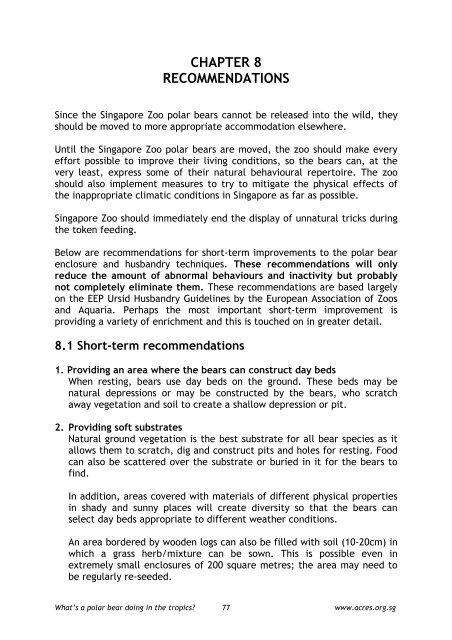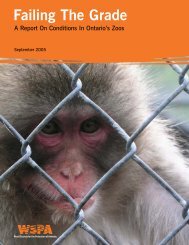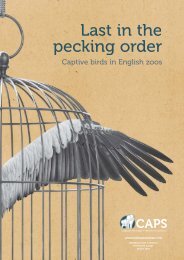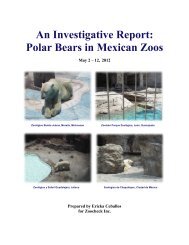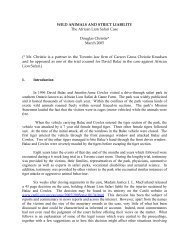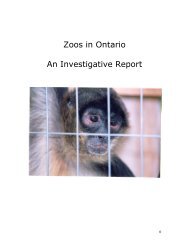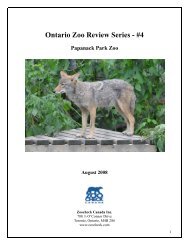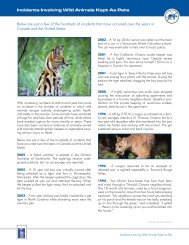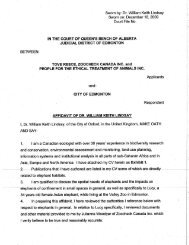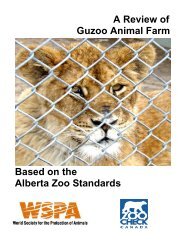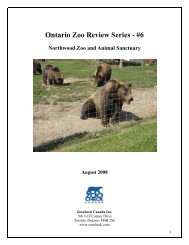What's a Polar Bear Doing in the Tropics? - Animal Concerns ...
What's a Polar Bear Doing in the Tropics? - Animal Concerns ...
What's a Polar Bear Doing in the Tropics? - Animal Concerns ...
You also want an ePaper? Increase the reach of your titles
YUMPU automatically turns print PDFs into web optimized ePapers that Google loves.
CHAPTER 8RECOMMENDATIONSS<strong>in</strong>ce <strong>the</strong> S<strong>in</strong>gapore Zoo polar bears cannot be released <strong>in</strong>to <strong>the</strong> wild, <strong>the</strong>yshould be moved to more appropriate accommodation elsewhere.Until <strong>the</strong> S<strong>in</strong>gapore Zoo polar bears are moved, <strong>the</strong> zoo should make everyeffort possible to improve <strong>the</strong>ir liv<strong>in</strong>g conditions, so <strong>the</strong> bears can, at <strong>the</strong>very least, express some of <strong>the</strong>ir natural behavioural repertoire. The zooshould also implement measures to try to mitigate <strong>the</strong> physical effects of<strong>the</strong> <strong>in</strong>appropriate climatic conditions <strong>in</strong> S<strong>in</strong>gapore as far as possible.S<strong>in</strong>gapore Zoo should immediately end <strong>the</strong> display of unnatural tricks dur<strong>in</strong>g<strong>the</strong> token feed<strong>in</strong>g.Below are recommendations for short-term improvements to <strong>the</strong> polar bearenclosure and husbandry techniques. These recommendations will onlyreduce <strong>the</strong> amount of abnormal behaviours and <strong>in</strong>activity but probablynot completely elim<strong>in</strong>ate <strong>the</strong>m. These recommendations are based largelyon <strong>the</strong> EEP Ursid Husbandry Guidel<strong>in</strong>es by <strong>the</strong> European Association of Zoosand Aquaria. Perhaps <strong>the</strong> most important short-term improvement isprovid<strong>in</strong>g a variety of enrichment and this is touched on <strong>in</strong> greater detail.8.1 Short-term recommendations1. Provid<strong>in</strong>g an area where <strong>the</strong> bears can construct day bedsWhen rest<strong>in</strong>g, bears use day beds on <strong>the</strong> ground. These beds may benatural depressions or may be constructed by <strong>the</strong> bears, who scratchaway vegetation and soil to create a shallow depression or pit.2. Provid<strong>in</strong>g soft substratesNatural ground vegetation is <strong>the</strong> best substrate for all bear species as itallows <strong>the</strong>m to scratch, dig and construct pits and holes for rest<strong>in</strong>g. Foodcan also be scattered over <strong>the</strong> substrate or buried <strong>in</strong> it for <strong>the</strong> bears tof<strong>in</strong>d.In addition, areas covered with materials of different physical properties<strong>in</strong> shady and sunny places will create diversity so that <strong>the</strong> bears canselect day beds appropriate to different wea<strong>the</strong>r conditions.An area bordered by wooden logs can also be filled with soil (10-20cm) <strong>in</strong>which a grass herb/mixture can be sown. This is possible even <strong>in</strong>extremely small enclosures of 200 square metres; <strong>the</strong> area may need tobe regularly re-seeded.What’s a polar bear do<strong>in</strong>g <strong>in</strong> <strong>the</strong> tropics?77www.acres.org.sg


